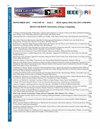Dosimetry Strategies for Non-Autonomous UV-C Robots
IF 1.3
4区 工程技术
Q3 COMPUTER SCIENCE, INFORMATION SYSTEMS
引用次数: 0
Abstract
This study aimed to evaluate the coverage and disinfection effectiveness of SIDUV-C, a non-autonomous UV-C robot operating at a wavelength of 254 nm and a power output of 3900 W, which made it the most powerful in its category. Experimental methods included the determination of UV irradiation doses, UV-Vis spectral analysis, and modeling of irradiance fields to estimate the systems ability to deliver adequate doses of UV energy to target surfaces or airborne pathogens. Commercially available dosimetric films sensitive to UV-C radiation were employed to quantify doses across different spatial regions, and their accuracy was validated against UV spectroradiometry techniques and microbiological assays with methicillin-resistant Staphyloccoccus aureus (MRSA). The results demonstrated that both dosimetric films and spectroradiometer measurements consistently indicated the robot's rapid and effective disinfection performance across an unshaded area of 12.25 m2. The doses delivered were sufficient to neutralize a wide range of bacterial species commonly found in hospital environments across Latin America, including multidrug-resistant pathogens, thus underscoring the potential of UV-C disinfection robots as a critical tool in mitigating antimicrobial resistance in healthcare settings.非自主UV-C机器人的剂量学策略
本研究旨在评估非自主UV-C机器人SIDUV-C的覆盖范围和消毒效果,该机器人的工作波长为254 nm,输出功率为3900 W,是同类机器人中功率最大的。实验方法包括测定紫外线照射剂量、紫外可见光谱分析和辐射场建模,以估计系统向目标表面或空气传播病原体提供足够剂量的紫外线能量的能力。采用市售的对UV- c辐射敏感的剂量测定膜来量化不同空间区域的剂量,并通过紫外光谱辐射测定技术和耐甲氧西林金黄色葡萄球菌(MRSA)的微生物测定来验证其准确性。结果表明,剂量学薄膜和光谱辐射计的测量结果一致表明,机器人在12.25平方米的无阴影区域内具有快速有效的消毒性能。所提供的剂量足以中和拉丁美洲各地医院环境中常见的多种细菌种类,包括耐多药病原体,从而强调了UV-C消毒机器人作为减轻医疗环境中抗菌素耐药性的关键工具的潜力。
本文章由计算机程序翻译,如有差异,请以英文原文为准。
求助全文
约1分钟内获得全文
求助全文
来源期刊

IEEE Latin America Transactions
COMPUTER SCIENCE, INFORMATION SYSTEMS-ENGINEERING, ELECTRICAL & ELECTRONIC
CiteScore
3.50
自引率
7.70%
发文量
192
审稿时长
3-8 weeks
期刊介绍:
IEEE Latin America Transactions (IEEE LATAM) is an interdisciplinary journal focused on the dissemination of original and quality research papers / review articles in Spanish and Portuguese of emerging topics in three main areas: Computing, Electric Energy and Electronics. Some of the sub-areas of the journal are, but not limited to: Automatic control, communications, instrumentation, artificial intelligence, power and industrial electronics, fault diagnosis and detection, transportation electrification, internet of things, electrical machines, circuits and systems, biomedicine and biomedical / haptic applications, secure communications, robotics, sensors and actuators, computer networks, smart grids, among others.
 求助内容:
求助内容: 应助结果提醒方式:
应助结果提醒方式:


